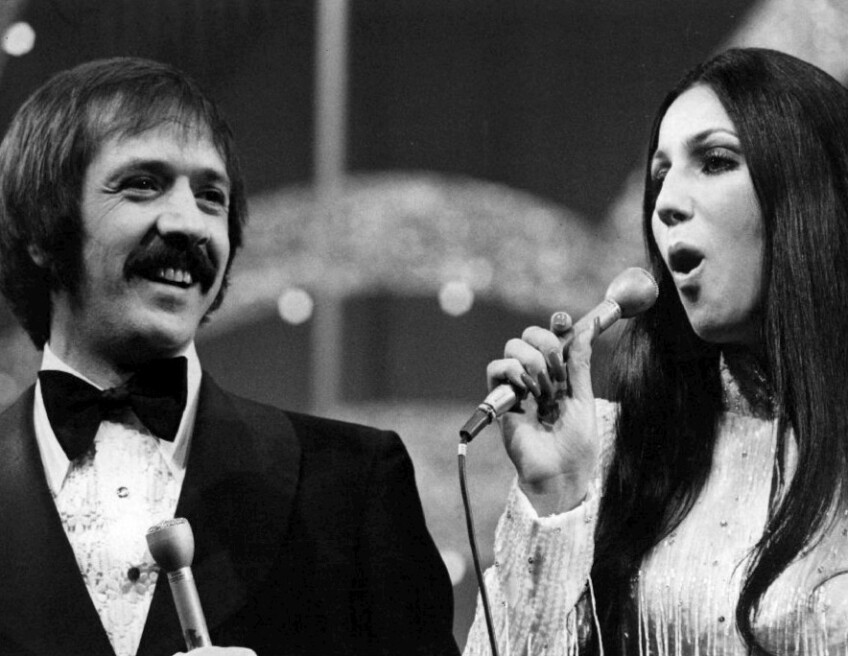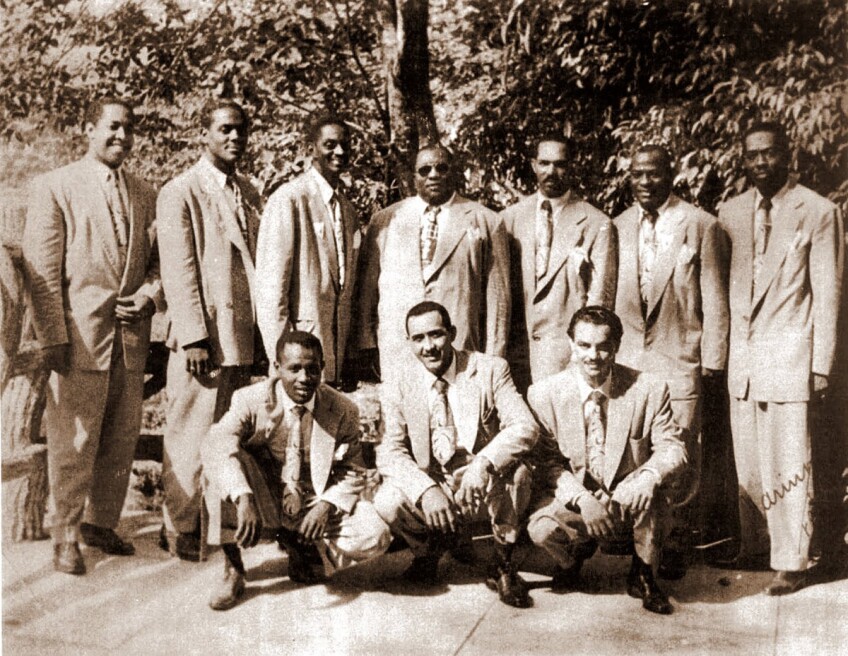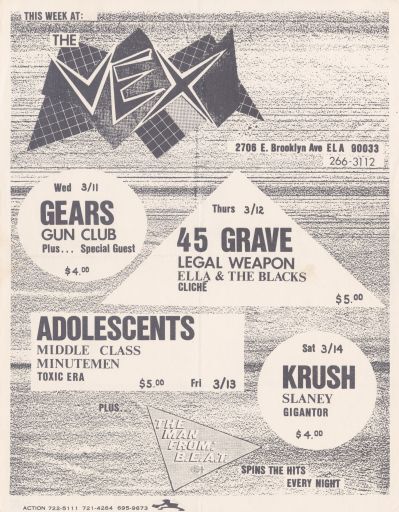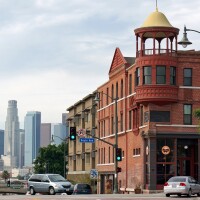Boyle Heights Arts Conservatory: A Century of Arts and Radical Community-Building

A steady flow of students, artists and audiophiles cycle in and out of the community arts center nestled on the ground floor of an unassuming three-story Italian renaissance revival building in Boyle Heights. Youth and adults alike eagerly participate in free arts classes organized by the Boyle Heights Arts Conservatory, a hub for creative arts located in a building standing on the corner of North Mott Street and East Cesar Chavez Avenue. Classes range from Dungeons & Dragons to stop motion animation workshops to introduction to DJing, YouTube and acting. It’s also home to an FCC-licensed community radio station.
Mixchel Payan, 20, is a college student who works there as a sound engineer. She helps produce and edit radio shows while co-hosting Mexica Matrix, a show focused on featuring local musicians and artists. Most recently, Payan and co-host Tochtli Orozco featured a live acoustic set by El Rio, a group from Northeast Los Angeles that plays Latin American folk rhythms, broadcasting to the station’s local and online listeners.
An avid music lover, Payan developed an interest in sound design as a student at the Ramón C. Cortines School of Visual and Performing Arts. “I realized I like being behind the scenes rather than acting,” says Payan, an East Los Angeles resident who is involved in the local art scene and is also the conservatory’s premier editing software expert. Eventually, she wants to work as a professional live-sound engineer.


A long history of arts and activism precedes the work of the Boyle Heights Arts Conservatory, which began programming in 2011. Historically, it has been a source of arts and culture in a neighborhood marked by demographic change, and more recently, a fight against displacement. Built in 1925, the building was a multipurpose community resource center run by Jewish socialists in the 1920s and 1930s. As The Paramount Ballroom in 1949, it hosted Tito Puente, Arsenio Rodríguez and other Latinx and African American musicians. The building was also home to The Vex, a roaming punk club born in 1980 East L.A.
Now, nearly 100 years after the building’s opening, in a return to its roots, it hosts 101.5 FM KQBH L.A., a community radio station run by a nonprofit dedicated to training local youth in arts and media. It is the newest iteration of community-based arts and organizing in a historic building in Boyle Heights — a sign of continuity grounded in radical community-building in Los Angeles’ Eastside.
Created in 2011, the Boyle Heights Arts Conservatory is committed to creating pathways to careers in film, television and media for Los Angeles youth. Conservatory staff began construction for the radio station at the end of 2018. Station manager and nonprofit executive director Carmelita Ramirez-Sanchez says access to careers in arts and media is limited for youth in the Los Angeles neighborhoods it serves.
The conservatory’s focus is grounded in the building’s history. “The building itself has a lot of social justice energy in it,” Ramirez-Sanchez says. “We want to give thanks to the building and honor what the building has been since 1925. With that spirit and with that energy, we make sure that there is always a collaborative environment here.”
Listen to a clip of Mexica Matrix, a radio program produced out of the conservatory below . Listen to more radio programs on 101.5 LPFM.
More stories from Boyle Heights
The Paramount Ballroom in 1940s-1960s
Music is the driving force of the conservatory’s programming. There are dozens of shows already on the air, including shows run by queer youth, and shows focusing on a wide array of genres including punk, ska, goth, reggae, hip-hop, doo-wop and oldies, among others. Often, musicians broadcasted by KQBH L.A. actually played in a venue housed in the building. This musical affinity in the building has deep roots.
More than 50 years ago, the building was The Paramount Ballroom, the site of interracial gatherings of musicians, dancers and audiences. It was an important dance and music venue that welcomed local and international artists. One of the earliest records of The Paramount appears in an April 1949 Los Angeles Times story announcing the opening of a dance studio run by Eduardo Cansino, a Spanish-born flamenco dancer and father of Hollywood star Rita Hayworth. The studio, though open for only a short stint, specialized in Mexican folkloric dance, flamenco, tap, ballet and boogie-woogie dancing.

Plenty of rumors swirl among those familiar with the building’s layers of music history. Strung together, these stories help reveal a rich history of the bands that filled bills at The Paramount. According to musician and author Mark Guerrero, The Blendells, a Mexican American soul group from East L.A., played a show with duo Caesar & Cleo, the first incarnation of Sonny & Cher. A 1983 compilation album, “The History Of Latino Rock Vol.1 1956-1965 The Eastside Sound,” includes The Blendells and features a photo of The Paramount Ballroom on the cover. Material archives of Lalo Guerrero’s performances at The Paramount Ballroom, where he headlined many shows, also exist: napkins from a 1955 performance and a handbill that reads “Lalo Guerrero Sings Pancho Lopez Davy Crockett” are housed in a special collections archive at UC Santa Barbara.

According to David F. Garcia, author of “Listening Across Boundaries: Soundings from the Paramount Ballroom and Boyle Heights,” by 1964, The Paramount Ballroom was hosting live music and dance every weekend. Divided into a nightclub on the bottom floor and ballroom on the second floor, The Paramount featured Cuban, Puerto Rican, African and Mexican American musicians. Bandleaders like Johnny Martínez would perform with Mariachi Los Reyes the night before Tito Puente played an afternoon show. Dick “Huggy Boy” Hugg, a rhythm and blues radio disc jockey and music promoter, hosted a dance at The Paramount featuring the African American doo-woop group The Six Teens in July 1963. Other local promoters like Johnny Jimenez, or “Johnny Jay,” started booking bands like The Leggeriors, whose lead singer Frankie Garcia would later start Cannibal & the Headhunters, and The Royal Jesters. He also booked African American bands like The Meadowlarks and The Medallions for shows at The Paramount Ballroom.
Afro Cuban music legend and composer Arsenio Rodríguez and his conjunto headlined gigs at The Paramount Ballroom thanks to an eight-month contract, performing every weekend through December 1965. Rodríguez, born in Cuba’s Matanzas Province, was an Eastside resident living up the street from The Paramount Ballroom on Wabash Street. He struggled to find an audience in larger venues, save for performances at the Hollywood Palladium and the Million Dollar Theatre. The Paramount Ballroom would be home to most of Rodríguez’s performances before he returned to New York City in 1966. Although the era of big bands at The Paramount Ballroom ended in the 1960s, the furor of the first-wave punk scene would bring music back to the space 20 years later.


The Vex Marks the Spot
In 1981, The Paramount Ballroom hosted The Vex, an all-ages club that featured East L.A. punk bands Los Illegals, The Brat, Nervous Gender, Thee Undertakers and the Stains. Other bands that played there included Black Flag, Circle Jerks, Adolescents, Bad Religion, The Weirdos and The Gun Club, among others. The Vex was created by beer distributor turned club promoter Joe Suquette, and Willie Herron, an artist and member of the aforementioned Los Illegals, along with the support of Self Help Graphics founder Sister Karen Boccalero. The club first opened on the floor above the original Self Help Graphics building on East Cesar Chavez Avenue and North Gage Avenue in 1980.
After a riot involving fans of punk band Black Flag forced the first venue’s closure, it moved to The Paramount Ballroom in 1981 for a few months before moving downtown, and finally to the former Copacabana club on Soto Street by 1983. Punks from all around the area, from Los Angeles to Orange County, would frequent The Vex. It was an important club in the Los Angeles punk scene and had a particular importance for local bands, some of whom didn’t feel welcome in the Westside’s venues. The whiteness of the Hollywood punk scene and the “hint of racism,” as The Brat lead singer Teresa Covarrubias said, repelled many Eastside punks and reinstated the importance of venues like The Vex.
Connecting to Boyle Heights’ Radical Jewish History
The building’s founders perhaps set the tone for the intense social life it would house in the coming decades. In the early 1920s, members of The Workmen’s Circle, one of the first Yiddish-based organizations in L.A., and Jewish socialists associated with the Cooperative Consumers League, a cooperative buying club, commissioned the construction of the building.
Boyle Heights at the time was home to a large Jewish immigrant population from Eastern Europe that either migrated directly or by way of cities like New York, Cleveland, St. Louis or Pittsburgh. They were mostly working class, employed in the garment industry and other industrial areas of downtown. Many joined unions and became labor leaders. By the end of the 1940s, there were approximately 50,000 Jews living in Boyle Heights. They shared the community with an increasing number of Mexicans, Japanese and African Americans, brought together by surrounding racism.
In September 1924, the Cooperative Consumers League applied for permission to erect the building and contracted architect Gregory R. Evans for the job, who built it the following year for $25,000. As The Cooperative Center, the newly minted building became an important center for socializing and organizing in Boyle Heights’ multi-ethnic community. The three-story building had several meeting rooms on the top floor, a large ballroom for lectures, rallies and social events in the middle, as well as a bakery and café on the ground floor. It was headquarters to the carpenters union, the painters union, Friends of the Soviet Union and the unemployed council. The bakery helped provide low-cost bread and was staffed by members of the Jewish Bakers Union 453, while the café served as a soup kitchen for struggling residents during the Great Depression.

According to The L.A. Times, the organizations within The Cooperative Center would call for rallies and distributed pamphlets and circulars against police harassment during the height of the Los Angeles Police Department (LAPD) Red Squad’s persecution of communists. In the 1930s, it was key in the organization of eviction protests throughout Boyle Heights and several large hunger marches downtown. In 1931, communist party members were arrested for helping Mexican and Filipino farm workers organize a strike against deplorable work conditions. In turn, the LAPD repeatedly targeted the building for raids.
Caroline Luce, a UCLA postdoctoral fellow and digital curator of the Mapping Jewish Los Angeles project, points out the subversive importance of The Cooperative Center’s organizing in Boyle Heights. “The active work to engage in intercultural dialogue, intercultural organizing and intercultural political protest was a very radical thing to do,” she says. After the police crackdown, organizations within The Cooperative Center disbanded and sold the building sometime in the 1940s. The venue was renamed The Paramount Ballroom and was owned and operated by brothers Mitch and Raymond Rodriguez, who owned several bars and clubs. But even during the ballroom’s heyday, it continued being a site of convergence for social organizing and community-building, having also hosted a public meeting of the Mexican American National Association in August 1952.
![The Paramount Ballroom, 1983. | Courtesy of the Ruben Guevara Records and Papers [ca. 1970-2004] from the UCLA Chicano Studies Research Center](https://kcet.brightspotcdn.com/dims4/default/03a0b1e/2147483647/strip/true/crop/790x508+0+0/resize/790x508!/quality/90/?url=http%3A%2F%2Fkcet-brightspot.s3.us-east-1.amazonaws.com%2Flegacy%2Fsites%2Fkl%2Ffiles%2Fthumbnails%2Fimage%2Fkcet05_guevara_scans.1.jpg)
Bridging History and Contemporary Radical Community Building

Though Boyle Heights itself has changed due to local housing covenants and structural inequality preventing access to housing, the building has remained a resource for a community that is continually in flux, bringing local and international artists and activists together in one place. It also represents a site that lends itself to forging of a sense of community based on cross-cultural and intergenerational activism and collaboration. It’s an energy that continues to send ripples throughout Los Angeles.
For the Boyle Heights Arts Conservatory, connecting with youth throughout Los Angeles is an important aspect of community-building. Over the summer, conservatory interns and volunteers are hosting workshops focused on radio production for formerly incarcerated youth.
Payan, who is involved in the workshops, says this is the type of work that helps redefine the meaning of community. “We’re young and now we have the opportunity to share our voice, so let’s do the same for the other young people of this community.”
“It’s a way to build bridges across different neighborhoods, different areas where people got pushed into. So many people found themselves in East L.A. because of their income, or so many people found themselves all the way out there because they couldn’t afford L.A. rent,” she says. “We’ve all been pushed out. We’ve all been segregated in, and it’s just about building bridges with those communities and seeing that we’re all connected.”
The Boyle Heights Arts Conservatory relies on a hybrid model of funding from for-profit businesses also housed in the building, which include The Brooklyn Pizza Company, which will open where the bakery was in the 1930s, and The Paramount upstairs. Both are set to open later this year. The issue of gentrification in Boyle Heights is ever-present for participants, so Ramirez-Sanchez says the Boyle Heights Arts Conservatory plans to literally and figuratively hold space for the community. It’s what the building has done since 1925.
“This is what the building wants to do,” she says. “She has made up her mind to say ‘no you won’t do anything else, you will continue to feed people, you will continue to educate people, you will continue to provide community and a space for them to do that.’”
Top Image: The Vex punk flyers and various artists associated with The Paramount Ballroom decorate the building's hallway today. | Andre Roman Medina

